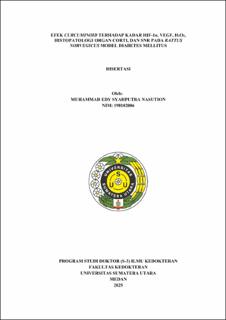Efek Curcuminoid terhadap Kadar HIF-1α, VEGF, H2O2, Histopatologi Organ Corti, dan SNR pada Rattus norvegicus Model Diabetes Mellitus
Effects of Curcuminoid on HIF-1α Levels, VEGF, H2O2, Organ of Corti Histopathology, and SNR in Rat Model of Diabetes Mellitus

Date
2025Author
Nasution, Muhammad Edy Syahputra
Advisor(s)
Ilyas, Syafruddin
Haryuna, Tengku Siti Hajar
Lindarto, Dharma
Metadata
Show full item recordAbstract
Background: Patients with Diabetes Mellitus (DM) are at high risk of experiencing hearing impairment. Cellular response to hypoxic conditions in DM involves an increase in Hypoxia-Inducible Factor-1 (HIF-1) levels. One of the genes regulated by HIF-1 is Vascular Endothelial Growth Factor (VEGF-A). Hyperglycemia leads to increased Reactive Oxygen Species resulting in hydrogen peroxide (H2O2) formation. DM also causes degeneration of the outer hair cells in the cochlea. Malondialdehyde (MDA) can be used as a biomarker of lipid peroxidation and oxidative stress caused by ROS. Curcuminoid has potential for various diseases. Currently, there is no proven medication that can prevent or repair damage to the organ of Corti caused by DM. The aim of this study is to prove the effects of curcuminoid in preventing and/or repairing damage to the organ of Corti in the cochlea based on HIF-1α, VEGF, and H2O2 levels, degeneration of outer hair cells, MDA expression in the organ of Corti, and SNR values among groups of Rattus norvegicus of DM model. Methods: This is an experimental laboratory study in vivo. Treatment administration was done randomly, double-blind, and included a control. Twenty-five Wistar strain Rattus norvegicus aged 2-3 months, male, weighing 150-250 grams were divided into five groups: group 1 was the DM group without curcuminoid, groups 2 and 3 were DM groups receiving curcuminoid at doses of 200 and 400 mg/kg BW respectively for 10 days, groups 4 and 5 were DM groups receiving curcuminoid at doses of 200 and 400 mg/kg BW respectively for 13 days. DM induction was performed by intraperitoneal injection of 150 mg/kg BW of alloxan. Curcuminoid used was from Curcuma longa with a curcuminoid content of 95%. Distortion Product Otoacoustic Emission (DPOAE) examination was conducted pre-alloxan induction, on the first, fourth, seventh, tenth, and thirteenth day after DM induction. Enzyme-Linked Immunosorbent Assay (ELISA) was performed to assess HIF-1α, VEGF-A, and H2O2 levels; histopathological examination of degeneration of outer hair cells and immunohistochemistry of MDA expression in the organ of Corti were conducted. Results: Significant differences were found in HIF-1α, VEGF-A, H2O2 levels, and SNR values among groups (p <0.05) as well as SNR values over time (p <0.05). Histopathological examination of degeneration of outer hair cells and immunohistochemistry of MDA expression in the organ of Corti showed statistically insignificant differences (p=0.068 and p=0.360) between groups after curcuminoid administration. Conclusion: Curcuminoid can prevent and/or repair damage to the organ of Corti in the cochlea based on differences in mean plasma levels of HIF-1α, VEGF-A, and H2O2, as well as SNR values among groups of Rattus norvegicus of DM model. However, they have not yet been able to prevent and repair degeneration of outer hair cells or reduce MDA expression in the organ of Corti.
Collections
- Doctoral Dissertations [185]
